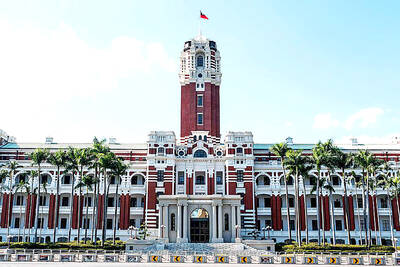The US art market is booming despite turmoil in the financial sector, thanks in part to foreign buyers encouraged by a weak dollar.
The fall auction season was marked by robust prices across most categories, with postwar and contemporary works in particular doing very well. Several new records were set, generating billions of dollars for auction houses such as Sotheby's, contributing to solid earnings but also exposing auctioneers to volatility when sales did not go as well as expected.
Experts credit the weak dollar, expanding world wealth and new buyers from countries not previously associated with the art collecting community. Over the past five years, wealthy buyers from Russia, China, India and the Middle East have helped fuel the market.

PHOTO: AP
"This is the first time in a long time where we've had truly universal world wealth expand ... It's a relatively new precedent that there is so much wealth being created all over the world," said Michael Moses, co-founder of the Mei Moses All Art Index, which looks at the historical performance of art as an investment and asset class.
These buyers -- not affected by the uncertain US economy -- paid astronomical amounts for art. An Andy Warhol painting sold for more than US$71 million in a May auction that brought in a total of nearly US$385 million. A Matisse fetched more than US$33.6 million in a November sale that also took in nearly US$400 million. A limestone lion sculpture that measures 8.2cm hauled in US$57 million earlier this month.
Still, the art market has not been immune to turbulence.
Sotheby's suffered a lackluster sale of modern and impressionist works in November after Van Gogh's The Fields -- estimated at US$28 million to US$35 million -- failed to sell and many other works sold below their estimates. Sotheby's stock plunged 28 percent that day because of investors' fears that the company had overextended itself in guaranteeing sellers' reserve -- the price the house promises to pay if a certain item does not sell.
"If you try to sell stuff for twice what it's worth, the market's going to say no," said Ian Peck, chief executive of the art-finance firm Art Capital Group.
He said that he heard that the Van Gogh later sold privately for about US$20 million.
Peck says his blanket advice to clients is to take a wait-and-see attitude for the next year and see how the art market plays out.
"Our view is that within 12 months we'll know if this thing is getting worse, meaning if a recession occurs in the US market or not," Peck said.
Generally, the art market trails the Dow Jones Industrial Average and other market indices by about six to eight months, Peck said. And stocks have been volatile, with big swings up and down, since the summer.
But he was optimistic that the art market would ride out the crisis and noted that his firm, which is essentially a private banker for art buyers, has seen a spike in loan applications to buy art. And people at auction houses are not really seeing much of a downturn because of the problems on Wall Street.
"If you look around, particularly in New York, it seems like everyone's a billionaire and they don't seem to be affected terribly by this credit crunch," said David Nash, of Mitchell-Innes and Nash, a private New York art consultancy and gallery specializing in impressionist, modern and contemporary masters.
Works by such modern artists as Warhol and Mark Rothko, and living artists including Richard Prince and Damien Hirst, are especially popular. In oil producing countries like the United Arab Emirates, the appetite is for modern American works by such artists as Keith Haring, Jean-Michel Basquiat and Warhol, Peck said.
"The most money is chasing these modern and contemporary names, and that's just what's in fashion really," Peck said.
Buyers with new money from Russia and China have a "limitless appetite for Western art and objects. Prices in some cases have doubled or tripled in the past year," he said.
Overall, Peck estimates that the art market gained about 18 percent last year -- not a bad return at a time of turmoil in the stock market.
"My experience over the last month or so is that there is a lot of money around, a lot of people looking to buy things," Nash said. "There are not very many people who've said I'm not going to buy this now because I'm worried about the state of the economy."

The CIA has a message for Chinese government officials worried about their place in Chinese President Xi Jinping’s (習近平) government: Come work with us. The agency released two Mandarin-language videos on social media on Thursday inviting disgruntled officials to contact the CIA. The recruitment videos posted on YouTube and X racked up more than 5 million views combined in their first day. The outreach comes as CIA Director John Ratcliffe has vowed to boost the agency’s use of intelligence from human sources and its focus on China, which has recently targeted US officials with its own espionage operations. The videos are “aimed at

STEADFAST FRIEND: The bills encourage increased Taiwan-US engagement and address China’s distortion of UN Resolution 2758 to isolate Taiwan internationally The Presidential Office yesterday thanked the US House of Representatives for unanimously passing two Taiwan-related bills highlighting its solid support for Taiwan’s democracy and global participation, and for deepening bilateral relations. One of the bills, the Taiwan Assurance Implementation Act, requires the US Department of State to periodically review its guidelines for engagement with Taiwan, and report to the US Congress on the guidelines and plans to lift self-imposed limitations on US-Taiwan engagement. The other bill is the Taiwan International Solidarity Act, which clarifies that UN Resolution 2758 does not address the issue of the representation of Taiwan or its people in

US Indo-Pacific Commander Admiral Samuel Paparo on Friday expressed concern over the rate at which China is diversifying its military exercises, the Financial Times (FT) reported on Saturday. “The rates of change on the depth and breadth of their exercises is the one non-linear effect that I’ve seen in the last year that wakes me up at night or keeps me up at night,” Paparo was quoted by FT as saying while attending the annual Sedona Forum at the McCain Institute in Arizona. Paparo also expressed concern over the speed with which China was expanding its military. While the US

SHIFT: Taiwan’s better-than-expected first-quarter GDP and signs of weakness in the US have driven global capital back to emerging markets, the central bank head said The central bank yesterday blamed market speculation for the steep rise in the local currency, and urged exporters and financial institutions to stay calm and stop panic sell-offs to avoid hurting their own profitability. The nation’s top monetary policymaker said that it would step in, if necessary, to maintain order and stability in the foreign exchange market. The remarks came as the NT dollar yesterday closed up NT$0.919 to NT$30.145 against the US dollar in Taipei trading, after rising as high as NT$29.59 in intraday trading. The local currency has surged 5.85 percent against the greenback over the past two sessions, central